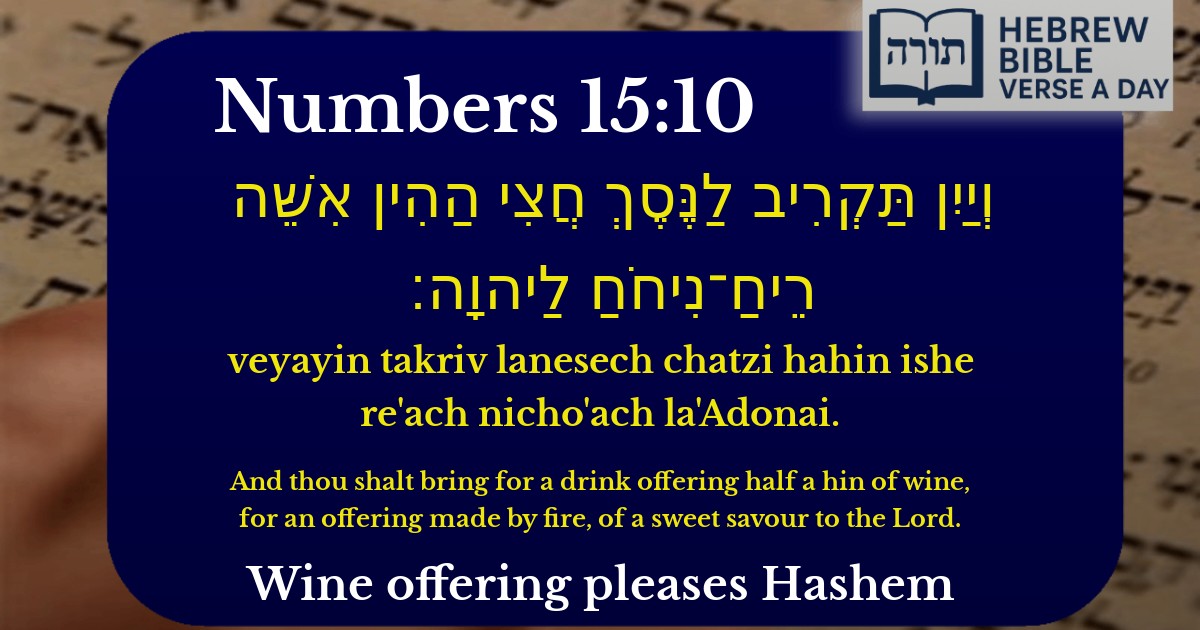Frequently Asked Questions
Q: What does the drink offering of wine represent in Numbers 15:10?
A: The drink offering of wine (נֶסֶךְ יַיִן) mentioned in Numbers 15:10 symbolizes joy and gratitude to Hashem. According to Rashi, it accompanies certain sacrifices to enhance the service, representing the worshiper's wholehearted devotion. The Talmud (Menachot 104b) explains that wine, which gladdens the heart, signifies the joy of serving G-d.
Q: Why is the amount 'half a hin' of wine specified in this verse?
A: The Torah specifies 'half a hin' (approximately 1.8 liters) to teach precision in serving Hashem. Rambam (Hilchos Maaseh HaKorbanos 2:4) explains that measurements in sacrifices reflect order and discipline in divine service. The Midrash (Bamidbar Rabbah 14:12) also notes that this amount balances sufficiency without excess, teaching moderation in spiritual devotion.
Q: What does 'a sweet savour to the Lord' mean in this context?
A: The phrase 'a sweet savour to the Lord' (אִשֵּׁה רֵיחַ־נִיחֹחַ) means the offering is pleasing to Hashem when brought with proper intent. Rashi explains that it reflects the worshiper's sincerity. The Talmud (Zevachim 46a) adds that the 'sweet savour' represents the acceptance of the Jewish people’s service when performed according to Halacha (Jewish law).
Q: How does the concept of a drink offering apply to Jewish practice today?
A: While physical drink offerings ceased with the destruction of the Temple, the Rambam (Moreh Nevuchim 3:46) teaches that prayer and Torah study now replace sacrifices. The idea of 'offering' wine reminds us to serve Hashem with joy (as wine symbolizes joy in Tehillim 104:15). Today, we express this through Kiddush on Shabbat, using wine to sanctify time with gratitude.
Q: Why is wine chosen for the drink offering instead of other liquids?
A: Wine is chosen because of its unique status in Jewish tradition. The Talmud (Berachos 35a) states wine is among the seven special species of Eretz Yisrael, and Rashi (on Bereishis 27:28) notes it represents blessing. Its use in offerings (as in Numbers 15:10) elevates physical pleasure into holiness, teaching that even worldly enjoyments can be sanctified for divine service.


Verse Context
The verse (Bamidbar 15:10) discusses the requirement to bring a נֶסֶךְ יַיִן (wine libation) alongside certain korbanot (sacrifices). The amount specified is חֲצִי הַהִין (half a hin) of wine, which is approximately 1.8 liters. This libation is described as an אִשֵּׁה רֵיחַ־נִיחֹחַ (offering made by fire, a pleasing aroma) to Hashem.
Rashi's Explanation
Rashi (Bamidbar 15:10) explains that the wine libation is poured onto the altar's base, as derived from Shemot 29:40. He notes that the amount of wine corresponds to the type of animal sacrifice:
This differentiation teaches that the libation's quantity aligns with the significance of the korban.
Rambam's Perspective
In Hilchot Maaseh HaKorbanot (2:1), the Rambam codifies the halachah that wine libations are obligatory for certain korbanot, including עוֹלָה (burnt offerings) and שְׁלָמִים (peace offerings). He emphasizes that the wine must be of high quality, as befitting an offering to Hashem.
Symbolism of Wine in the Midrash
The Midrash (Bamidbar Rabbah 15:7) connects wine libations to joy, as wine symbolizes simcha (joy) in Jewish tradition. The act of pouring wine on the altar represents dedicating one's happiness to divine service. Additionally, the Sforno (Bamidbar 15:10) suggests that wine, which intoxicates if misused, is sanctified through this offering, teaching that even physical pleasures can be elevated for spiritual purposes.
Halachic Details from the Talmud
The Talmud (Menachot 104b) discusses the precise measurements of libations and rules that the wine must be:
This underscores the importance of both physical and spiritual purity in divine service.